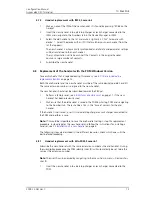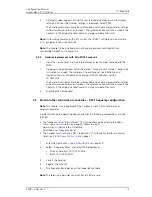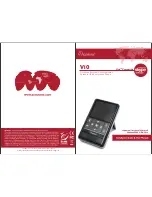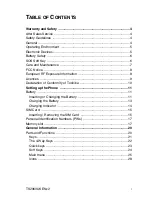
TD 92639GB
2009-12-08/ Ver. C
Configuration Manual
Ascom d62 DECT Handset
27
The feature Shared phone allows more than one user to use a handset. When a handset is
configured to be a shared phone, it can be used by any shared phone user in the system.
Extension and messages will be user unique. Messages and call lists are deleted when a
user logs off a handset. Contacts, settings, licenses, and Bluetooth devices will be
common for all shared phone users of the same handset.
The parameter Default Master ID determines which IP-DECT Master the handset shall
logon to. In a small IP-DECT system where a single IP-DECT Master is used, the parameter
shall not be changed (default ID is "0").
In a large IP-DECT system where several IP-DECT Masters are used, the parameter may be
changed depending on which IP-DECT Master that shall be used.
If the handset shall logon another IP-DECT Master, the user can override the default
Master ID by entering Master ID followed by the User ID.
<*><Master ID><*><User ID>
In a template or Number in PDM/IMS2, the parameter is found at:
Systems > Common > Shared Phone
Note:
When registering a handset for the first time in the PDM, the Number (User ID) will
be equal to the handset’s extension number. If another user logs on the same handset, the
Number will be unchanged. It is recommended to rename Number to, for example, Shared
X (where X is a number) to prevent number conflict if assigning several shared phone
handsets the same extension when subscribing towards the IP-DECT system. Renaming
the handset in PDM will also make it easier to find and administrate the handset in PDM.
See also
User Manual, Ascom d62 DECT Handset, TD 92477GB
for information on how to
log on a handset.
It is possible to log off a handset when it is placed in a charger. In the PDM, select
Connections > In charger > Logout.
5.31 Push-to-Talk (PTT) Group Call
Note:
Messaging group(s) must be defined in the IMS2. See
Installation and Operation
Manual, IMS2, 92586GB
.
To be able to call a PTT group (PTT Voice Style), its properties must also be set. Using the
PDM and the "Edit template" feature, and select Push to Talk > PTT X ( (where X
represents the groups 1 to 10).
The following parameters can be set:
• Group number - The Messaging group number that is defined in IMS2.
• Display text - This text appears in the display when the PTT group call is connected.
• Indication - Depending on the handsets in a PTT group, they may receive the PTT
invitation as a message (PTT Message Style).
• Conference number - The phone number to the conference bridge (PTT server) that is
provided by the system administator.
• Answer mode - Determines if the PTT call shall be automatically or manually answered.
• Speaker mode - Determines if the PTT call shall be answered in loudspeaker mode.










































